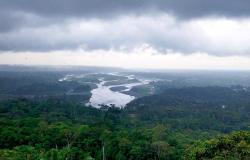Latin America’s outsized role in climate change mitigation

Alfredo Toro Hardy explores why the region that holds the most important green lung on the planet needs support to play a leading role in climate change mitigation.
In a 2023 update report, the International Energy Agency (IEA), the world’s leading energy authority, warned that the possibility of a benign outcome resulting from climate change mitigation policies was receding. While climate was warming fast, the shift from fossil to alternative fuels was not moving fast enough. This countered the Agency’s conclusions in a 2021 report, which stated that a narrow but still feasible path existed for limiting the rise of global temperature to 1.5 C. degrees above pre-industrial levels (IEA, 2021 and 2023). Moreover, in an October 2023 study, a group of scientists concluded that the planet had over five years before global warming exceeded that temperature goal (Lamboll, Nicholls, Smith, Kikstra, Byers and Rogelj, 2023).
As the world approaches climate catastrophes, much worse than those experienced so far, it is important to ascertain the role to be played by the different regions of the planet in cushioning climate change. In this regard, Latin America emerges as an outlier. The region’s contribution to climate change mitigation goals can be ferreted out from three different perspectives: Firstly, by its inverse correlation between climate change responsibility and energy transition efforts. Secondly, through the preservation of its rainforests. Thirdly, by mining the critical minerals required for global energy transition. Let’s review where Latin America stands in these areas.
Being a minor contributor to climate change, with just 5 percent of co2 emissions on global scale, the region has seriously assumed energy transition. The World Economic Forum’s Energy Transition Index, which measures the energy system performance in regard to clean energy sources in 115 countries, shows that Latin America is well positioned internationally. Its 2023 average within such index was 54,8 percent, just below Advanced Economies with 65,2 percent and Emerging Europe with 57,7 percent (Siemens Energy, 2022; World Economic Forum, 2023, p. 18). Moreover, according to the IEA: “Latin America is one of the world’s leading regions for renewable energy use today and one that can play a major role in the international push for low-carbon hydrogen, a crucial element of a global net-zero emissions future” (IEA, 2021, p. 7). Hence, while being positioned on a lower range of global responsibility for climate change, it has shown seriousness in pursuing clean energy objectives. This proves Latin America’s light footprint on climate change
While evidencing the above light footprint, the region holds the most important green lung on the planet: The Amazon rainforest. Spanning eight South American countries (plus French Guyana), and encompassing 6.7 million square kilometers (twice the size of India), it is not only the world’s largest tropical forest but its largest drainage system. While accounting for more than half of the total volume of rainforest worldwide, it houses 10 percent of the planet’s biodiversity and absorbs one-fourth of the CO2 absorbed by all the land on Earth (National Geographic/Education; WWF). In a presidential summit held in Brazil, in August 2023, Bolivia, Brazil, Colombia, Guyana, Peru, Suriname and Venezuela launched an alliance to protect the Amazon. Through an ambitious shared agenda, aimed at promoting sustainable development, end deforestation and to fight the organized crime that fuels it, the eight governments involved pledged to save this crucial buffer against climate change. Shortly before the summit, the Peruvian Environment Minister informed onlookers that there was consensus amid said governments, in relation to a zero-deforestation policy (Aljazeera, 2023; Rochabrun, 2023).
But together with its light climate change footprint, and its role as the preserver of more than half of the total volume of rainforest worldwide, Latin America tops the list of global reserves on critical minerals required for energy transition. The region, thus, is at the epicenter of the essential resources needed for the manufacturing and storage of clean technologies and energies. Among these minerals are lithium, graphite, cooper, zinc, niobium, cobalt, nickel, silver, or rare earth, which are used in the production of electric batteries, solar panels, winds turbines, electric cars, and other key devices for clean energy generation or storage. Roughly two-thirds of the world’s global lithium reserves are in Latin America, primarily in Bolivia, Argentina and Chile, but also in Mexico, Peru and Brazil. Chile, Peru and Mexico hold an estimated 45 percent of global cooper reserves, with additional reserves found in Argentina, Brazil, Colombia, and Ecuador. The region also holds 34 percent of the global reserves of silver, 24 percent of graphite, and 17 percent of nickel, zinc and rare earths. Brazil alone has 80 percent of the global niobium reserves. Moreover, Chile and Peru are the world’s leading cooper producers with about 40 percent of the global supply, while Chile and Argentina account for 32 percent of the world’s lithium supply (Purdy and Castillo, 2022, p. 4; Ríos, 2023; Center on Global Energy Policy, 2023).
Latin America is, thus, a key player in energy transition and climate change mitigation. However, two considerations are in line. First, the Amazon rainforest’s zero-deforestation policy can occasionally enter into conflict with the mining of critical minerals needed for clean energy transitions. As a result, a compromise should be attained between two equally desirable objectives for mitigating the effects of climate warming. A United Nations’ sponsored code of conduct, balancing both objectives, and aiming at controlling the negative impacts associated with mining and mineral processing upon local ecosystems and local communities, would be highly desirable. Support from the international community would help regional governments to withstand the leverage of big multinational mining interests.
Second, the region should not become a sacrificial zone on behalf of limiting the global rise of temperature. A distributive justice, in which costs and benefits are allocated among various stakeholders, should apply in this regard. If humanity as a whole benefits from preserving the Amazon rainforest, advanced economies with a high climate change footprint, are logical stakeholders within this process. As a matter of fact, in August 2023, the presidents or prime ministers of a dozen rainforest countries, that included 11 Latin American and Caribbean ones, plus the Republic of Congo, formed a pact to demand developed countries to help developing ones preserve biodiversity. A united front was thus forged among them for future international negotiations, including the United Nations COP28 climate summit due to be held later this year. Said countries, expressed concerns that richer nations have not delivered on their promises to provide climate financing support to developing countries (Spring, 2023).
Latin America plays, indeed, a very important role in climate change mitigation, but it needs support in order to withstand the leverage of big mining interests and preserve, as untouched as possible, half of the total volume of the world’s rainforest.
Alfredo Toro Hardy, PhD, is a retired Venezuelan career diplomat, scholar and author. Former Ambassador to the U.S., U.K., Spain, Brazil, Ireland, Chile and Singapore. Author or co-author of thirty-six books on international affairs. Former Fulbright Scholar and Visiting Professor at Princeton and Brasilia universities. He is an Honorary Fellow of the Geneva School of Diplomacy and International Relations and a member of the Review Panel of the Rockefeller Foundation Bellagio Center.
Photo by Ben Traveling
References
Aljazeera (2023). “Amazon nations launch alliance to protect rainforest at key summit”, 9 August.
Center on Global Energy Policy at Columbia School of International and Public Affairs (2023). “Critical Minerals in Latin America: A Bridge or a Bottleneck for the Energy Transition”, June 5.
IEA (2021). “Hydrogen in Latin America: From Near-Term Opportunities to Large-Scale Deployment”.
IEA (2021), “Net Zero Emissions by 2050: A Roadmap for the Global Energy Sector”.
IEA (2023). “Net Zero Roadmap: A Global Pathway to Keep the 1.5 C Goal in Reach”, Update.
Lamboll, R.D., Nicholls, Z.R. J., Smith, C.J., Kikstra J.S., Byers, E. and Rogelj, J. (2023). “Assessing the size and uncertainty of remaining carbon budgets”, Nature Climate Change, 30 October.
National Geographic/Education. “The Amazon Rainforest Collection”.
Purdy, C., Castillo, R. (2022). “The Future of Mining in Latin America: Critical Minerals and the Global Energy Transition”, Leveraging Transparency to Reduce Corruption/Brookings Institution.
Ríos, G. (2023). “Strategic minerals: Collaboration between LATAM and the Caribbean, Spain, and the EU”, El País, 5 October.
Rochabrun, M., “South America Will Pledge to End Amazon Deforestation by 2030”, Bloomberg, July 20.
Siemens Energy (2022). “Latin America: An Energy Powerhouse with Global Potential”, Latin America Energy Week, June 8-10.
Spring, J. (2023). “Rainforest countries form a pact to demand conservation cash from rich nations”, Reuters, August 9.
World Wildlife Fund. “Inside the Amazon”.
World Economic Forum (2023). “Fostering Effective Energy Transition”.


